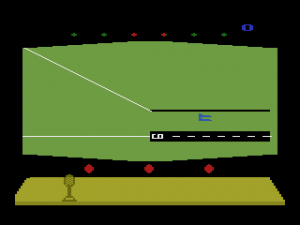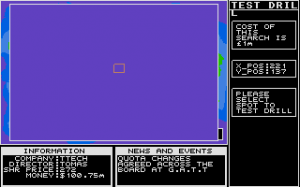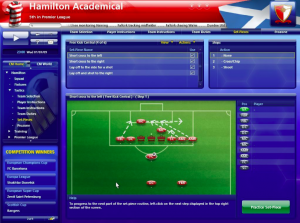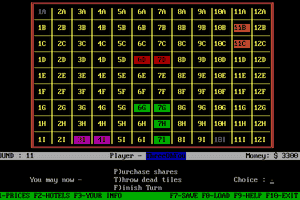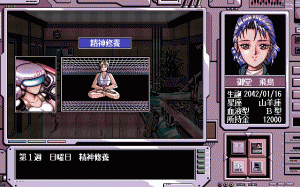Game Classification
Restaurant Empire II Enlight Software Ltd., Enlight Entertainment Europe Ltd., 2009
Classification
VIDEO GAMEKeywords
Market
This title is used by the following domains:- Entertainment
Audience
This title targets the following audience:Age : 12 to 16 years old / 17 to 25 years old
General Public
Gameplay
The gameplay of this title is Game-based(designed with stated goals)
The core of gameplay is defined by the rules below:
Similar games
Restaurant Empire II is a food establishment management game and the sequel to Restaurant Empire. The Campaign mode contains a remastered version of the story mode of the first game, as well as a new campaign with sixteen scenarios. In addition, the Sandbox mode is open-ended where custom goals and rules can be implemented. In the Campaign mode the player lives the life of the young chef Armand LeBoeuf.
Two main views are used to manage the restaurant. There is a city view where the surroundings are shown and where it is possible to travel to different establishments, as well as other city venues. At the start of the game a plot of land or a building is purchased. Important factors are then the size of the restaurant and the general cuisine. Most of the time is however spent in the restaurant interior view. The building is decorated with objects, seats, rooms and textures, lighting and various accessories. Most items have at least two attributes, based on comfort and decoration (attractiveness). Not only the main rooms need to be designed, there needs to be a fully functional kitchen and restrooms as well.
The next step is selecting recipes and adding these to the food menu. Depending on the type of cuisine (restaurant, coffee shop or dessert house), there are various offerings that can be gathered in up to five courses for a reasonable price. For each recipe the ingredients are shown, with the quantity, cost, and overall rating (choosing a lower quality rating helps the bottom line, but can keep customers unsatisfied for instance). Each recipe also has a certain cooking time and specific requirement for the kitchen. The game keeps track of the most popular recipes in the establishment through a ranking. There is a wide selection of suppliers, with some special ones that offer rare ingredients. The final step of the menu involves adding beverages and for instance splitting them up in lunch and dinner. Once everything is set and the staff is hired, the restaurant is opened. Management then includes watching over the preparation of the means, inventory management and making sure the customers are attended to. As in most managerial simulations there are many factors to keep into account: the amount of cash available, profit, seat occupancy, customer and staff satisfaction, ... At any time it is possible to demolish the building and start over, but also to upgrade the restaurant, both on the outside as well as the interior design.
While playing it is possible to track every individual customer and view reports of the staff. There are also some special customers marked by a green arrow. These open up new events with a brief conversation. They offer rare ingredients, provide new supplies, or buy or sell recipes. In the campaign mode specific goals need to be met to progress through the scenarios. More complex management includes staff training, advertisements, loans, recipe research, specific policies, live performances, or for instance introducing a uniform for all staff members. Chefs can also participate in cooking contests to get a better rating and evolve to star chefs, making it possible to raise the overall menu price in the meantime. Managing chefs is a separate department, with assignments to specific types of food, an inventory of skills and ingredients, and an overall reputation.
Next to the main game there is an Adventure mode where it is possible to walk around in the city and visit different locations or participate in cooking contests (also done through mini-games). In this mode additional items can be selected that can be stored in the inventories of the different chefs, to provide new ingredients or skills.
Compared to the first game, there has been a large graphical overhaul, two new enterprise categories (coffee shop and dessert house, in addition to the restaurant that was already present), over 600 recipes from regional cuisines (German for instance, in addition to French, Italian and American from the first game), new interior themes, 700 new interior objects (in addition to the 700 already present), new locations to start a business (Munich in Germany is new for instance, in additional to Paris, Los Angeles and Rome), live performances to please customers, and more detailed recipe management. [source:mobygames]
Distribution : Retail - Commercial
Platform(s) : PC (Windows)
Two main views are used to manage the restaurant. There is a city view where the surroundings are shown and where it is possible to travel to different establishments, as well as other city venues. At the start of the game a plot of land or a building is purchased. Important factors are then the size of the restaurant and the general cuisine. Most of the time is however spent in the restaurant interior view. The building is decorated with objects, seats, rooms and textures, lighting and various accessories. Most items have at least two attributes, based on comfort and decoration (attractiveness). Not only the main rooms need to be designed, there needs to be a fully functional kitchen and restrooms as well.
The next step is selecting recipes and adding these to the food menu. Depending on the type of cuisine (restaurant, coffee shop or dessert house), there are various offerings that can be gathered in up to five courses for a reasonable price. For each recipe the ingredients are shown, with the quantity, cost, and overall rating (choosing a lower quality rating helps the bottom line, but can keep customers unsatisfied for instance). Each recipe also has a certain cooking time and specific requirement for the kitchen. The game keeps track of the most popular recipes in the establishment through a ranking. There is a wide selection of suppliers, with some special ones that offer rare ingredients. The final step of the menu involves adding beverages and for instance splitting them up in lunch and dinner. Once everything is set and the staff is hired, the restaurant is opened. Management then includes watching over the preparation of the means, inventory management and making sure the customers are attended to. As in most managerial simulations there are many factors to keep into account: the amount of cash available, profit, seat occupancy, customer and staff satisfaction, ... At any time it is possible to demolish the building and start over, but also to upgrade the restaurant, both on the outside as well as the interior design.
While playing it is possible to track every individual customer and view reports of the staff. There are also some special customers marked by a green arrow. These open up new events with a brief conversation. They offer rare ingredients, provide new supplies, or buy or sell recipes. In the campaign mode specific goals need to be met to progress through the scenarios. More complex management includes staff training, advertisements, loans, recipe research, specific policies, live performances, or for instance introducing a uniform for all staff members. Chefs can also participate in cooking contests to get a better rating and evolve to star chefs, making it possible to raise the overall menu price in the meantime. Managing chefs is a separate department, with assignments to specific types of food, an inventory of skills and ingredients, and an overall reputation.
Next to the main game there is an Adventure mode where it is possible to walk around in the city and visit different locations or participate in cooking contests (also done through mini-games). In this mode additional items can be selected that can be stored in the inventories of the different chefs, to provide new ingredients or skills.
Compared to the first game, there has been a large graphical overhaul, two new enterprise categories (coffee shop and dessert house, in addition to the restaurant that was already present), over 600 recipes from regional cuisines (German for instance, in addition to French, Italian and American from the first game), new interior themes, 700 new interior objects (in addition to the 700 already present), new locations to start a business (Munich in Germany is new for instance, in additional to Paris, Los Angeles and Rome), live performances to please customers, and more detailed recipe management. [source:mobygames]
Distribution : Retail - Commercial
Platform(s) : PC (Windows)
 Français
Français English
English





